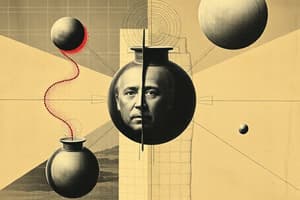Podcast
Questions and Answers
According to Newton's First Law, an object in constant motion requires an unbalanced force to maintain its velocity.
According to Newton's First Law, an object in constant motion requires an unbalanced force to maintain its velocity.
False (B)
Inertia is not a property of matter that describes an object's resistance to acceleration.
Inertia is not a property of matter that describes an object's resistance to acceleration.
False (B)
If the net force acting on an object is doubled, the object's acceleration will be halved, assuming its mass remains constant, according to Newton's Second Law.
If the net force acting on an object is doubled, the object's acceleration will be halved, assuming its mass remains constant, according to Newton's Second Law.
False (B)
Action and reaction forces, as described by Newton's Third Law, act on the same object.
Action and reaction forces, as described by Newton's Third Law, act on the same object.
When a rocket takes off, the action force is the fuel exhaust pushing down, and the reaction force is the rocket being pushed upwards.
When a rocket takes off, the action force is the fuel exhaust pushing down, and the reaction force is the rocket being pushed upwards.
The Apollo 13 mission successfully landed on the moon despite an oxygen tank bursting.
The Apollo 13 mission successfully landed on the moon despite an oxygen tank bursting.
According to Newton's First Law, when a ship accelerates forward, astronauts accelerate 'forwards' due to inertia.
According to Newton's First Law, when a ship accelerates forward, astronauts accelerate 'forwards' due to inertia.
In an experiment testing the effect of mass on acceleration, the applied force should be a controlled variable.
In an experiment testing the effect of mass on acceleration, the applied force should be a controlled variable.
In a graph of net force vs. acceleration, the relationship is inverse.
In a graph of net force vs. acceleration, the relationship is inverse.
If the applied force on a cart is decreased, the inverse curve on a graph will move further from the axis.
If the applied force on a cart is decreased, the inverse curve on a graph will move further from the axis.
Flashcards
Static Equilibrium
Static Equilibrium
Forces are balanced, object is not moving.
Dynamic Equilibrium
Dynamic Equilibrium
Forces are balanced, object is moving at constant velocity.
Newton's First Law
Newton's First Law
Object at rest stays at rest, object in motion stays in motion unless acted upon by unbalanced force
Role of Inertia
Role of Inertia
Signup and view all the flashcards
Newton's Second Law
Newton's Second Law
Signup and view all the flashcards
Newton's Third Law
Newton's Third Law
Signup and view all the flashcards
Inertia
Inertia
Signup and view all the flashcards
Fnet = ma
Fnet = ma
Signup and view all the flashcards
Inverse Relationship
Inverse Relationship
Signup and view all the flashcards
Net Force Increase
Net Force Increase
Signup and view all the flashcards
Study Notes
- Newton's Laws are being tested
Free Body Diagrams
- Static equilibrium involves forces balanced at rest
- Dynamic equilibrium involves forces balanced while moving at a constant velocity
Newton's First Law
- An object at rest stays at rest, and an object in motion stays in motion with the same speed and in the same direction unless acted upon by an unbalanced force, this is called inertia
- Mass determines how much inertia an object has
- Inertia is a property of matter that describes an object's resistance to acceleration
- Force is not inertia
- Inertia causes an object in motion to remain in motion and a stationary object to remain stationary
- In space travel, objects travel in a straight line unless a force acts upon them
Newton's Second Law
Fnet = m * adescribes how an object's motion changes when a force is appliedFg = m * gcan also be used, whereg = 9.81 m/s²- Use a free body diagram to find
Fnet - Acceleration has an inverse relationship with mass
- Acceleration has an equal relationship with force
Newton's Third Law
- Every action has an equal and opposite reaction, these occur in pairs with equal magnitude and opposite direction
Rocket Action and Reaction
- Taking off involves the rocket pushing down on the fuel exhaust (action), and the fuel exhaust pushing up on the rocket (reaction)
- Moving through space involves the rocket pushing down on fuel exhaust (action), and fuel exhaust pushing up on the rocket, accelerating it in space (reaction)
Apollo 13 Movie
- The film follows three astronauts: Jim Lovell (commander), John Swigert, and Fred Haise
- The astronauts attempted to land on the moon, but were unable to due to an oxygen tank bursting
- The crew had to do a free trajectory return and landed safely, but they never made it to the moon
- The astronauts are pushed back on their seats because as the ship accelerates forward, the astronauts accelerate backwards due to inertia
- They accelerate or exert a force when they burn the engine
- The rocket pushes down on the fuel exhaust, and the fuel exhaust pushes up on the rocket causing the rocket to accelerate away from the Earth
Newton's Second Law Lab
- The experiment tested how different amounts of mass affected the acceleration of a cart
- The amount of mass was increased by 0.5kg increments, and then the cart was released and the acceleration recorded
- The independent variable was the mass of the cart (kg)
- The dependent variable was the acceleration of the cart (m/s²)
- The controlled variable was applied force (about 0.5N, mass hanger plus mass on hanger = 50g)
- The relationship between the mass of the cart and the acceleration of the cart is inverse, since as mass increases, acceleration decreases
- The relationship and graph between net force and acceleration is linear:
Fnet = m * a
Net Force/Applied Force (Controlled Variable)
- If net force increases, the acceleration of the cart increases, since acceleration has an equal relationship with force
- If net force decreases, the acceleration of the cart decreases, since acceleration has an equal relationship with force
Mass on the Cart (Independent Variable)
- If mass increases, the acceleration of the cart decreases, since acceleration has an inverse relationship with mass
- If mass decreases, the acceleration of the cart increases, since acceleration has an inverse relationship with mass
- If the applied force/controlled variable increases, the further the inverse curve moves away from the axis
- If the applied force/controlled variable decreases, the closer the inverse curve moves to the axis
Studying That Suits You
Use AI to generate personalized quizzes and flashcards to suit your learning preferences.




